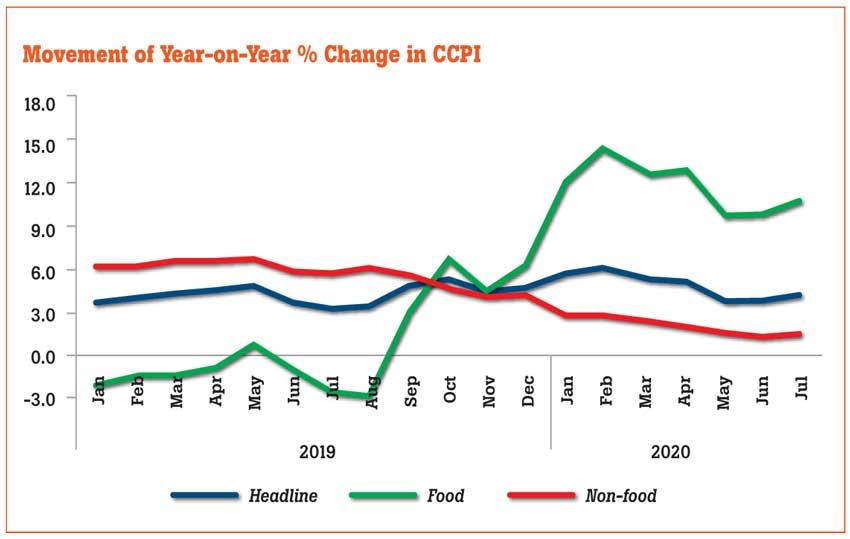04 Aug 2020 - {{hitsCtrl.values.hits}}

Sri Lanka’s inflation measured by the Colombo Consumer Price Index (CCPI) increased in July from a month ago, driven mostly by the price increases in non-food items such as healthcare, clothing and transport, as people who were mostly confined to their homes left for workplaces with the lockdowns fully lifted.
The headline inflation measured by the CCPI rose by 4.2 percent during the 12 months to July 2020, from 3.9 percent in June, as non-food items showed some increment from a month ago while the lower base in July 2019 also had some effect on the index.
“This was mainly driven by the monthly increase of prices of items in the non-food category along with the statistical effect of the low base prevailed in July 2019,” said the Statistics Department of the Central Bank.
Meanwhile, the so-called core prices or core inflation, measured barring the often volatile items such as food and energy, ticked up to 3.2 percent during the 12 months to July, from 3.1 percent in June.
The Central Bank maintains its year-end inflation range at the original mid-single-digit levels, between 4 percent and 6 percent, unless there could be a significant supply-side shock, as the economy is growing far below its potential due to the coronavirus impact, which undermines the demand-driven price pressures.
The non-food prices rose by 0.1 percent on a month-on-month (MoM) basis while the prices increased by 1.5 percent from a year ago, accelerating from 1.4 percent in June.
The healthcare subcategory recorded the most increase in the price, with a 0.08 percent increase from June, as payments to private hospitals or nursing homes rose followed by the prices paid for medical-related or pharmacy products in July.
People who avoided visiting hospitals due to fears of the coronavirus appear to have restarted visiting them for their medical needs.
Meanwhile, the clothing and footwear subcategory rose by 0.02 percent from a month ago, as the office-based workers, who mostly worked from home, went back to their workplaces while the schools reopened although the latter had been closed again when the potential community transmission of the disease emerged.
Alongside clothing, the transport subcategory also rose by 0.02 percent on an MoM, mostly on account of tyres, tubes and spare parts, as more people used private vehicles for their commute while the periodic repairs, which could not be performed during the virus-related lockdowns, may have been attended to.
Meanwhile, the housing, water, electricity, gas and other fuels subcategory and more specifically the maintenance and reconstruction work-related prices, declined in July, as more people went out of their houses.
The prices of alcoholic beverages, tobacco and narcotic subcategory, also showed some decline.
Meanwhile, the food prices rose by 0.1 percent in July on an MoM basis, after rising 2.6 percent in June on an MoM basis but the prices rose by 10.9 percent during the 12 months to July, up from 10.0 percent in June.
Turmeric powder led the food price inflation as the price of the crucial spice remained abnormally elevated during and after the pandemic, as imports were banned and the local production remains grossly insufficient to meet the demand.
The prices of turmeric powder rose by 0.11 percent in July, from June.
Among the other food items that saw price increases were: fresh fruits, potatoes, eggs, rice flour, papadam, biscuit, green chillies, canned fish, margarine, noodles, green gram, chicken, coconut and a few others.
Meanwhile, the prices of vegetables, red onions, fresh fish, chilli powder, limes, dried fish, garlic, coconut oil, gram, beef, dhal mysoor, big onions, pepper, curry powder and tea dust/leaves, saw decreases.
01 Jan 2025 25 minute ago
01 Jan 2025 2 hours ago
01 Jan 2025 4 hours ago
01 Jan 2025 5 hours ago
01 Jan 2025 5 hours ago